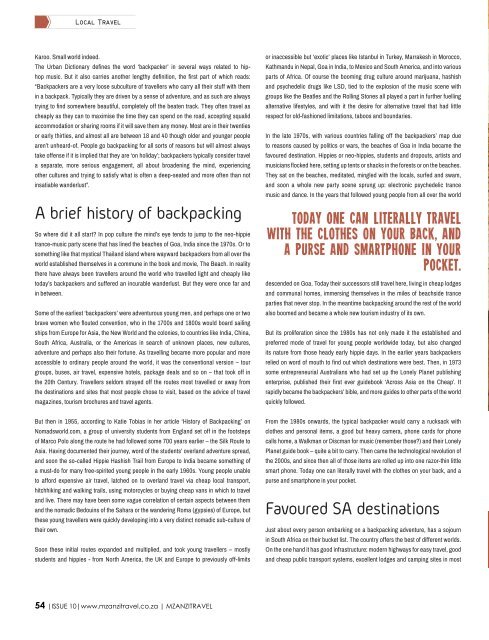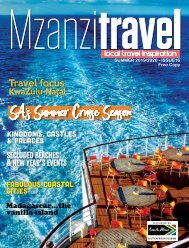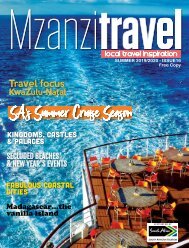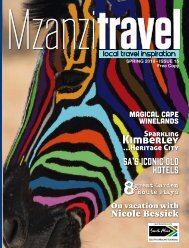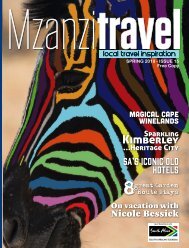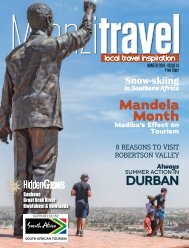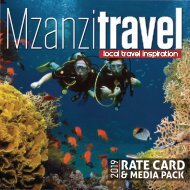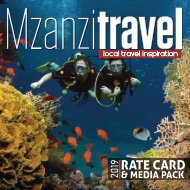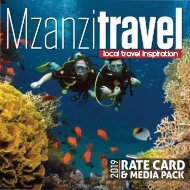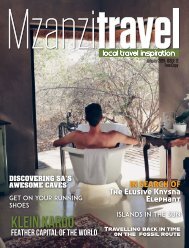Create successful ePaper yourself
Turn your PDF publications into a flip-book with our unique Google optimized e-Paper software.
Local Travel<br />
Karoo. Small world indeed.<br />
The Urban Dictionary defines the word ‘backpacker’ in several ways related to hiphop<br />
music. But it also carries another lengthy definition, the first part of which reads:<br />
“Backpackers are a very loose subculture of travellers who carry all their stuff with them<br />
in a backpack. Typically they are driven by a sense of adventure, and as such are always<br />
trying to find somewhere beautiful, completely off the beaten track. They often travel as<br />
cheaply as they can to maximise the time they can spend on the road, accepting squalid<br />
accommodation or sharing rooms if it will save them any money. Most are in their twenties<br />
or early thirties, and almost all are between 18 and 40 though older and younger people<br />
aren’t unheard-of. People go backpacking for all sorts of reasons but will almost always<br />
take offense if it is implied that they are ‘on holiday’; backpackers typically consider travel<br />
a separate, more serious engagement, all about broadening the mind, experiencing<br />
other cultures and trying to satisfy what is often a deep-seated and more often than not<br />
insatiable wanderlust”.<br />
A brief history of backpacking<br />
So where did it all start? In pop culture the mind’s eye tends to jump to the neo-hippie<br />
trance-music party scene that has lined the beaches of Goa, India since the 1970s. Or to<br />
something like that mystical Thailand island where wayward backpackers from all over the<br />
world established themselves in a commune in the book and movie, The Beach. In reality<br />
there have always been travellers around the world who travelled light and cheaply like<br />
today’s backpackers and suffered an incurable wanderlust. But they were once far and<br />
in between.<br />
Some of the earliest ‘backpackers’ were adventurous young men, and perhaps one or two<br />
brave women who flouted convention, who in the 1700s and 1800s would board sailing<br />
ships from Europe for Asia, the New World and the colonies, to countries like India, China,<br />
South Africa, Australia, or the Americas in search of unknown places, new cultures,<br />
adventure and perhaps also their fortune. As travelling became more popular and more<br />
accessible to ordinary people around the world, it was the conventional version – tour<br />
groups, buses, air travel, expensive hotels, package deals and so on – that took off in<br />
the 20th Century. Travellers seldom strayed off the routes most travelled or away from<br />
the destinations and sites that most people chose to visit, based on the advice of travel<br />
magazines, tourism brochures and travel agents.<br />
or inaccessible but ‘exotic’ places like Istanbul in Turkey, Marrakesh in Morocco,<br />
Kathmandu in Nepal, Goa in India, to Mexico and South America, and into various<br />
parts of Africa. Of course the booming drug culture around marijuana, hashish<br />
and psychedelic drugs like LSD, tied to the explosion of the music scene with<br />
groups like the Beatles and the Rolling Stones all played a part in further fuelling<br />
alternative lifestyles, and with it the desire for alternative travel that had little<br />
respect for old-fashioned limitations, taboos and boundaries.<br />
In the late 1970s, with various countries falling off the backpackers’ map due<br />
to reasons caused by politics or wars, the beaches of Goa in India became the<br />
favoured destination. Hippies or neo-hippies, students and dropouts, artists and<br />
musicians flocked here, setting up tents or shacks in the forests or on the beaches.<br />
They sat on the beaches, meditated, mingled with the locals, surfed and swam,<br />
and soon a whole new party scene sprung up: electronic psychedelic trance<br />
music and dance. In the years that followed young people from all over the world<br />
Today one can literally travel<br />
with the clothes on your back, and<br />
a purse and smartphone in your<br />
pocket.<br />
descended on Goa. Today their successors still travel here, living in cheap lodges<br />
and communal homes, immersing themselves in the miles of beachside trance<br />
parties that never stop. In the meantime backpacking around the rest of the world<br />
also boomed and became a whole new tourism industry of its own.<br />
But its proliferation since the 1980s has not only made it the established and<br />
preferred mode of travel for young people worldwide today, but also changed<br />
its nature from those heady early hippie days. In the earlier years backpackers<br />
relied on word of mouth to find out which destinations were best. Then, in 1973<br />
some entrepreneurial Australians who had set up the Lonely Planet publishing<br />
enterprise, published their first ever guidebook ‘Across Asia on the Cheap’. It<br />
rapidly became the backpackers’ bible, and more guides to other parts of the world<br />
quickly followed.<br />
But then in 1955, according to Katie Tobias in her article ‘History of Backpacking’ on<br />
Nomadsworld.com, a group of university students from England set off in the footsteps<br />
of Marco Polo along the route he had followed some 700 years earlier – the Silk Route to<br />
Asia. Having documented their journey, word of the students’ overland adventure spread,<br />
and soon the so-called Hippie Hashish Trail from Europe to India became something of<br />
a must-do for many free-spirited young people in the early 1960s. Young people unable<br />
to afford expensive air travel, latched on to overland travel via cheap local transport,<br />
hitchhiking and walking trails, using motorcycles or buying cheap vans in which to travel<br />
and live. There may have been some vague correlation of certain aspects between them<br />
and the nomadic Bedouins of the Sahara or the wandering Roma (gypsies) of Europe, but<br />
these young travellers were quickly developing into a very distinct nomadic sub-culture of<br />
their own.<br />
Soon these initial routes expanded and multiplied, and took young travellers – mostly<br />
students and hippies - from North America, the UK and Europe to previously off-limits<br />
From the 1980s onwards, the typical backpacker would carry a rucksack with<br />
clothes and personal items, a good but heavy camera, phone cards for phone<br />
calls home, a Walkman or Discman for music (remember those?) and their Lonely<br />
Planet guide book – quite a bit to carry. Then came the technological revolution of<br />
the 2000s, and since then all of those items are rolled up into one razor-thin little<br />
smart phone. Today one can literally travel with the clothes on your back, and a<br />
purse and smartphone in your pocket.<br />
Favoured SA destinations<br />
Just about every person embarking on a backpacking adventure, has a sojourn<br />
in South Africa on their bucket list. The country offers the best of different worlds.<br />
On the one hand it has good infrastructure: modern highways for easy travel, good<br />
and cheap public transport systems, excellent lodges and camping sites in most<br />
54 |ISSUE <strong>10</strong>|www.mzanzitravel.co.za | MZANZITRAVEL<br />
Daleen Loest / shutterstock.com


